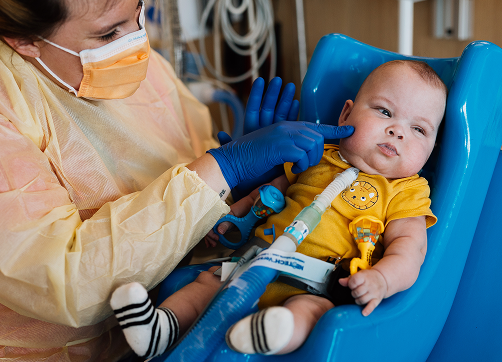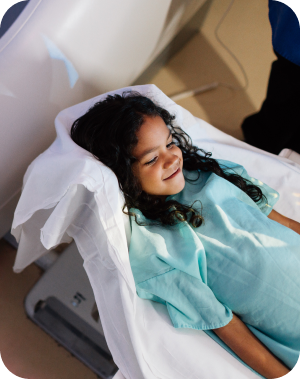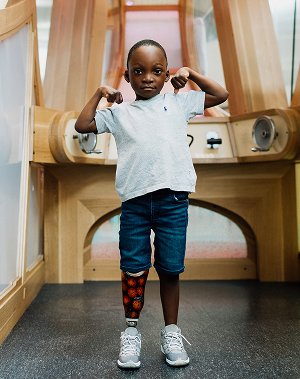jackson weiss syndrome


about condition
Jackson-Weiss syndrome (JWS) is a genetic congenital condition characterized by craniosynostosis and particular malformations of the feet and toes. The syndrome is generally apparent at birth. Craniosynostosis is the premature fusion/closure of certain skull bones and affects the shape of the head and facial bones.
Symptom severity varies widely among individuals, even in the same family. Rarely, an affected individual will not be born with craniosynostosis. The bones in the feet, the big toe, and the second and third toes may be malformed, which is frequently seen. Most all with this syndrome have typical intelligence but there may be some exceptions. As with other craniosynostosis conditions, there can be overlap with features; therefore, genetic testing is recommended to determine the correct syndrome. Early management of the craniosynostosis is important.
characteristics of this syndrome may include:
- Skull bone malformations; premature closure of sutures (craniosynostosis)
- Misshapen head/facial malformations
- Bilateral bulging forehead
- Increased intracranial pressure (rise of pressure inside skull)
- Possible abnormal fluid accumulation in cavities of the brain (hydrocephalus)
- Eye issues: strabismus, down-slanting eyes, widely spaced eyes, ptosis (upper eyelid is lower than usual), proptosis (protrusion of eye)
- Malformed midface area (creating a malocclusion and/or misalignment of the upper and lower jaws/teeth)
- Flattened cheekbones
- Prominent nose; pointed and/or curved nasal ridge
- Presence of a high and narrow palate (roof of mouth is arched)
- Possible cleft palate (opening in the roof of mouth)
- Prominent chin due to protrusion of lower jaw
- Malformed feet and toes (bones in feet may be affected, short broad big toe, 2nd and 3rd toes fused or curved)
- Hearing loss is rare
- Typical intelligence; rare learning challenges
*Surgical intervention may include cranial vault and midface distraction procedures to improve functions early on, as well as other necessary procedures as the child grows.
how do I know if my child will be born with this condition?
Sometimes when an ultrasound is performed during pregnancy, a doctor may notice non-typical signs which require additional testing to reveal more, such as in-depth 2D or 3D ultrasounds or fetal MRI. After birth, clinical examinations and other testing such as CT scans and MRI can help to diagnose the syndrome. Since Jackson-Weiss syndrome is an autosomal dominant condition, if one of the parents has the syndrome and knows their gene-causing mutation locations, genetic testing may be performed for the fetus to determine if the baby has a positive result as well. A positive parent has a 50 percent chance of passing it on; therefore, genetic counseling is recommended.


how do you treat Jackson-Weiss syndrome?
The treatment is focused on the specific symptoms apparent in each individual since the symptoms vary widely. Several specialties and physicians may be involved throughout the child’s life, such as craniofacial and reconstructive surgeries to correct skull and facial malformations. Patients may see some or all of the following physician specialties: otolaryngologist (ENT), audiologist, neurologist/neurosurgeon, ophthalmologist, orthopedist, dentist and more. Early intervention may be important to ensure that children with this syndrome reach their full potential. Special services and therapies may be beneficial.
FAQs
Very rare. Males and females appear to be affected equally. The incidence of cases is unknown at this time.
Yes, JWS is a congenital syndrome often apparent at both. The inheritance is an autosomal dominant pattern, which means the condition has a 50 percent chance of being passed from a positive parent to a child. Some cases of this syndrome are inherited while others are spontaneous new occurrences for the first time in a family.
Even though surgeries may often be in their future, individuals with this condition should have a typical life span. Early medical management of the craniosynostosis is important for the growth of the child.
- FGFR3
JWS is caused by genetic changes in the FGFR2 gene. This gene is responsible for providing instructions to the protein for multiple functions including the development of bone and brain tissue. A mutation change in a specific part of the FGFR2 gene overstimulates signaling by the FGFR2 protein, which promotes the premature fusion of skull bones and affects the development of facial bone and the bones in the feet as well.
- Jackson-Weiss craniosynostosis
- JWS
- Apert syndrome
- Pfeiffer syndrome
- Crouzon syndrome
- Carpenter syndrome
- Saethre-Chotzen syndrome
here when you need us
Whether you’re looking for the right provider, ready to make an appointment, or need care right now—we’re here to help you take the next step with confidence.
